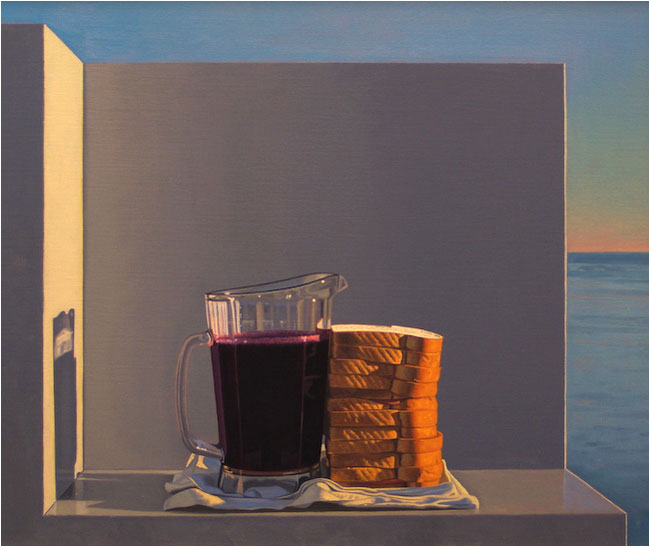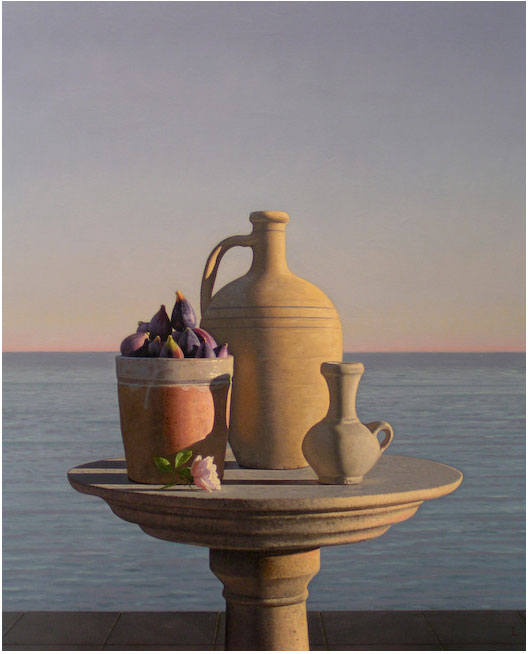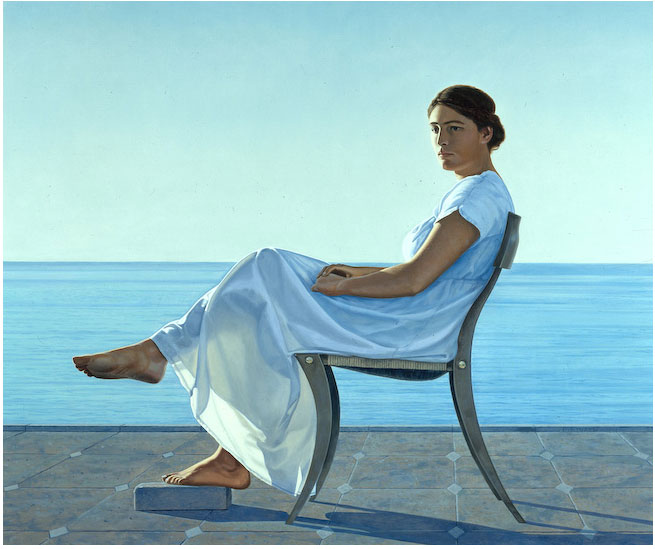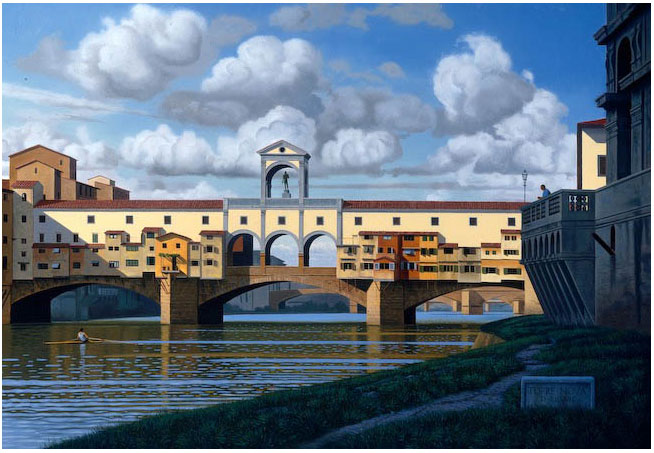
David Ligare Still Life with Grape Juice and Sandwiches (Xenia), 1994 | oil on canvas, 20 x 24 inches
Cezanne famously said something to the affect of his “wanting to bring Poussin back to life by way of nature.” Richard Shiff discusses this in depth in his excellent book, ” “Cezanne and the End of Impressionism: A Study of the Theory, Technique, and Critical Evaluation of Modern Art” He suggests that Cezanne followed Poussin’s lead to create a classicism that is a “living” tradition and not regurgitation of lifeless academic dogma. Schiff talks about how both Poussin and Cezanne brought classicism back to life through their contact with nature.

Still Life with Figs and Rose (Egyptian Style), 2007 | oil on canvas, 40 x 32 in.
David Ligare is unapologetic in his carrying forward the classical traditions in his work. However, unlike some neo-classical painters today Ligare’s painting not only has a strong pulse but also a modern spirit and a compelling personal vision. Ligare says in a very interesting interview on his website ” Personal expression and having a personal style are very important to many artists but I’ve been much more interested in how we see – what I call perceptual analysis…”
He had a number of thoughtful ideas in this interview, I don’t have time to review this in depth I will mention that when asked about Plato’s disdain of imitation he said: “That said, the artist who makes a critical reconstruction of reality is not necessarily deceiving the eye but instead revealing the nature of reality rather than reality itself. He or she is practicing the art of perceptual analysis – that is, looking carefully at something, analyzing why it looks the way that it does and then recreating it critically. And the key here is that we see what we know. Both art and nature are languages and, unless we understand their vocabularies, our knowledge of them is limited.”

Penelope, 1980 | oil on canvas, 40 x 48 in.
David Ligare shows at the Hackett Freedman Gallery in San Francisco and the Koplin Del Rio Gallery in LA. A catalog of his work can purchased from the Hackett Freedman Gallery

Ponte Vecchio/ Torre Nova, 1996 | oil on canvas, 40 x 58 in





When I spied Ligare’s Ponte Vecchio bridge painting I realized I was smiling. It reminded me of nothing so much as the countless hours I spent as a small boy with my wonderful set of wooden block building just such bridges, towers, forts, and other monuments to childhood imagination. I bet Ligare played with blocks too.
I’ve been trying to think of how to say something in relation to Ligare’s work…. I’m glad to see Philip went first.
This is what I love about art…. that there can be something 100% opposite from everything I do, feel, and believe as an artist, and yet be 100% valid, and even oddly beautiful…. certainly thought provoking, as Philip demonstrates.
Watching TV news, seeing pistol carrying armed opposition to a current point of view politically, and language that, at any other time might have brought about a whipping in the public square, it’s really refreshing to have art as a way of life that’s so basically opposed to this …. the lies, the cover-up’s, and the false beliefs being presented as TRUTH… as if any one has any idea what something called TRUTH might be.
Would I ever attempt a painting along the lines of Ligare’s? I hope not…… nor do I even think there’s anything in it for me personally to learn from, but I’m happy as hell it’s being done, being exhibited, and now being put up on this blog so we can see it.
That’s what arts all about!
Ligare’s paintings are beautiful, elegant pieces of art despite their appearance of moments forever frozen in time. Though they are not the pinnacle of 20/21st century painting, they are of very high quality.
Having said that, if I were him, I would have refrained from displaying Ponte Vecchio piece alongside the other paintings. It appears like good children book illustration, but nothing more than that.
The Ponte Vecchio painting is an example of schematic representation – a colored-in drawing where everything is seen equally and treated with equal attention – the “reality” of atmosphere and quality of light on material in space is airbrushed away. This is lazy painting. Mix up a big pile of one color and apply it to the whole wall of a building because of the idea in one’s mind that “that’s the color that the wall is”. The eye worked for about 5 seconds and then the brain and hand took over for the remaining 50 hours it took to paint the thing.
Take a look at Corot’s View of St Peters and Castel Sant’Angelo at http://www.the-athenaeum.org/art/full.php?ID=23658 to see what I think this painter should have studied more carefully.